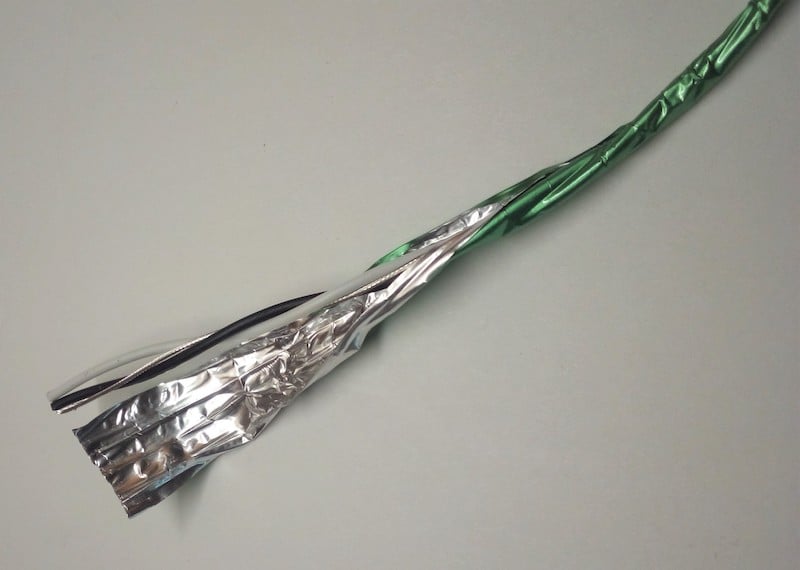Within an industrial setting, noise from EMI can create huge problems. For large load devices using many amps of current, small electrical noise may not be too critical. But when it comes to low-voltage and low-current communication wires, just a small amount of voltage finding its way onto a wire can corrupt data transmissions. Shielded cables can help to protect against that problem.
Reliable data communication is one of the two main emphasis points of design in an industrial control system. Any time two digital systems must ‘talk’ to each other, we want that communication to be as fast as possible, and as reliable as possible.
Reliability is hampered by many external factors inside an industrial facility. Every coil, motor, solenoid, or current-carrying AC wire will generate induction, which has an effect of creating (or inducing) voltage onto any other conductor nearby. For many of the large industrial components, even several feet or more away can still experience problems.
Another issue that arises when multiple conductor bundles travel near each other is capacitance. If voltage is applied to a wire, another wire next to it will see a voltage through a phenomenon called capacitive coupling.
It almost goes without saying that if an electrical wire causes a change in the voltage of a communication wire, that communication signal will no longer be valid. There are a few solutions, but a very common one is the use of shielded cables, which seem to only show up in communication cables. We will examine the reason and hardware behind this simple type of equipment.
What is Shielding?
Have you ever walked into a building with sheet metal walls or a roof and immediately your cell phone loses reception? This is also common in newer construction where many buildings are constructed with steel beams and metal studs in the walls.
The reason the buildings block the cell signal is that those signals are nothing more than electromagnetic (EM) oscillations in the radio frequency band that carry information. The metal between the EM source and the cell phone absorbs the RF signal, creating a small voltage on the wall, but preventing it from reaching you. If that metal is grounded, then the signal also is transmitted uselessly to ground.
In the case of cell reception, the blocked signal was a poor side effect. But if that RF signal is harmful, then a blocked signal would be a benefit. This concept is called a ‘Faraday Cage’ when you design a fully metal enclosure to block all outside RF noise. The denser the metal around you, the better the protection. Sometimes a thin metal grid, or mesh, provides sufficient protection, but sometimes a fully-encased metal wall is the only reliable solution.
Now if we apply this same concept to a wire, we can see that it would be useful to try and build a small Faraday Cage around the wire. If we consider digital communication on a wire to be similar to the antenna of a cell phone, it will pick up any noise from RF sources nearby. Industrial devices are powerful and in close proximity to the cables.
If we surround the cable with a wire mesh, it will offer a good deal of protection. But a solid, thick metal jacket is the best. If one or both ends of the cable are grounded, then the signal will be harmlessly blocked and dissipated to the nearest ground conductor.
Methods of Shielding
There are a few varieties of shielding around cables, all of which are quite common. You may not have seen the shielding, but it quite likely has existed in many of the cables you have worked with in the past.
The most common is a thin metal foil or tape wrapped entirely around the length of the cable, just under the insulation jacket (see Figure 1). From the outside, it doesn’t look any different, but the cable ends will usually be metallic. This is a giveaway in an Ethernet cable of any category — if the end connector is encased in metal, it is almost certainly a shielded cable. If you were to peel back the plastic jacket, you would see a thin aluminum foil layer.
Figure 1. A twisted pair set of wires with a green foil shield wrapped around the cable to prevent interference. The twisting of the wires helps to further reduce internal capacitive interference between the wires.
Sometimes the shielding is not as dense and may take the form of a mesh. Similarly, if you could peel back the plastic or rubber jacket, you would see a woven metallic layer adding protection but also some rigidity.
Coax cable, which means ‘co-axial’ consists of a metal signal carrier or two in the middle of an insulative core, then wrapped with a woven shield, and finally covered with a rubber or PVC outer jacket. In this case, the metallic shield provides not only the reduction of noise, but also the reference ground for the signal, making these cables ideal for radio, audio, and other single-direction signals.
There are always a few downsides to any upgrade, and in this case, the downsides are an added cost of special shielded cables and the extra loss of flexibility that comes from the rigid metal layer inside the cables. But these are small sacrifices to pay for reliable, high-speed communication.
Shielding Protects Against EMI
Shielding protects against unwanted interference from external electromagnetic sources. These shields can be solid or woven, usually just under the cable’s outer jacket, providing a small Faraday Cage to absorb and block those unwanted interference signals.
Copyright Statement: The content of this website is intended for personal learning purposes only. If it infringes upon your copyright, please contact us for removal. Email: admin@eleok.com

